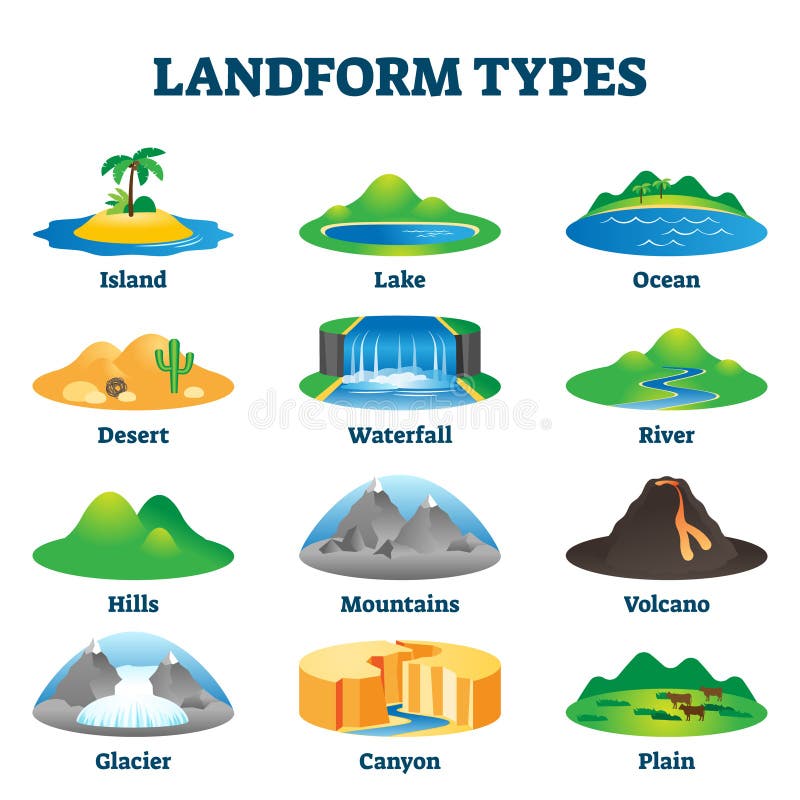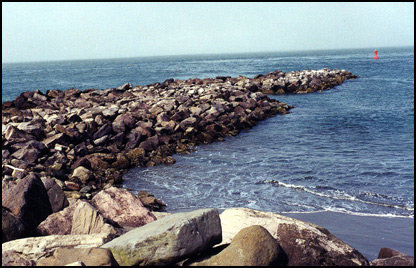
A natural shape or feature of Earth’s surface is a ____________________.
landform, topography, sand dune, delta, sinkhole, earthquake, fault, magma, volcano, jetty
landform

A ____________________ is a wall-like structure that sticks out into the ocean.
landform, topography, sand dune, delta, sinkhole, earthquake, fault, magma, volcano, jetty
jetty

The collapse of an underground cave may produce a ____________________.
landform, topography, sand dune, delta, sinkhole, earthquake, fault, magma, volcano, jetty
sinkhole

A sand hill formed and shaped by wind is a ____________________.
landform, topography, sand dune, delta, sinkhole, earthquake, fault, magma, volcano, jetty
sand dune

A break in Earth’s crust is called a ____________________.
landform, topography, sand dune, delta, sinkhole, earthquake, fault, magma, volcano, jetty
fault

Below the Atlantic Ocean floor, two plates move apart. What is beginning to develop?
a. a ridge
b. a mountain
c. a trench
d. a volcano
a. a ridge
Which cause is correctly paired with its effect?
a. volcano--sand dune
b. Earthquake--delta
c. mountain--deposition
d. river--canyon
volcano- sand dune
* they are both landforms created by the accumulation of material over time*
Which landform is most likely to be produced by windblown sand?
a. Canyon b. Delta c. mesa d. sand dune
d. sand dune
Running water erodes both sides of a rock formation. Which formation will result?
a. sand dune b. plain c. mountain d. mesa
d. mesa
Which of these landforms was LEAST shaped by erosion?
a. Mesa b. Plain c. canyon d. delta
d. delta
Seagrass has begun to grow on a sand dune. How is the seagrass MOST likely to modify the effects that natural processes have on the sand dune?
a. The dune will move toward the land.
b. The dune will move toward the ocean.
c. The dune will erode more quickly.
d. The dune will erode more slowly and may even grow bigger.
d. The dune will erode more slowly and may even grow bigger.
The water in a fast-moving river causes rocks to bump and scrape against one another. What will happen to these rocks over time?
a. They will get larger.
b. They will get smaller.
c. They will get sharper.
d. They will get heavier.
b. They will get smaller.
Which is NOT a way that plants affect landforms?
a. by weathering rock with chemicals
b. by adding new nutrients to the soil
c. by weathering rock with their roots
d. by holding soil in place with their roots
by weathering rock with chemicals
Which of these is formed when plates of the Earth’s crust bend and crack?
a. lava b. magma c. the mantle d. fault
d. fault
What process forms most mountains?
a. the oozing of lava from a vent
b.an explosion of lava from a vent
c. the cracking of Earth’s crust
d. the movement of Earth’s plate
d. the movement of Earth’s plate
Which does NOT happen because two plates collide?
a. Pressure builds.
b. Deltas form.
C. Earthquakes occur.
d. Earth’s surface crumples and folds.
b. Deltas form.
A seismologist sets up an experiment like this. What are they trying to find out? ↓
a. Where will the earthquake occur?
b. When will the earthquake occur?
c. How will the earthquake affect the structure?
d. How strong is the earthquake?
c. How will the earthquake affect the structure?
There is a relationship between landforms and the movement of water. Given this relationship, which of the following landforms is the result of weathering?
a. canyon b. desert c. forest d. mountain
a. canyon
How does GPS technology help seismologists study earthquakes?
a. It helps them measure the fault movement during earthquakes.
b. It helps them predict where an earthquake is likely to happen.
c. It helps them predict when an earthquake is likely to happen.
d. It sends out warnings that an earthquake is occurring.
a. It helps them measure the fault movement during earthquakes.
How does a dam help control flooding?
a. It is too high for water to rise above.
b. It holds back high water and releases it slowly.
c. It allows sediment in floodwaters to move downstream.
d. It offers a natural method of flood control
b. It holds back high water and releases it slowly.
Joshua spends the day at the beach with his family. He finds some smooth stones in the sand (like in the picture). What process causes such stones to become smooth? —-------->
a. Deposition b. erosion c. grooving d. weathering
d. weathering
Notice the ice splitting the rock. To which process does the ice contribute? —------------->
a. deposition b. Erosion c. polishing d. weathering
d. weathering
There is a relationship between landforms and wind. Given this relationship, which landform is the result of deposition?
a. a canyon b. a desert c. a forest d. a mountain
b. a desert
The movement of water can cause erosion. Which of the following choices is a result of water erosion?
a. barrier islands
b. canyons
c. small rocks
d. smooth stones
all of choices
barrier islands, canyons, small rocks, smooth stones
Different types of plate motion produce boundaries that shape different landforms and cause different natural events. Which event will most likely occur where two plates move in different directions and slide against each other?
a. an earthquake b. a fault c. a flood d. a volcano
a. an earthquake
Wind, water, and ice are involved in both weathering and erosion. However, weathering and erosion are two different processes. Which sentence states a difference between weathering and erosion?
a. Erosion moves rocks without breaking them down.
b. Weathering and erosion move rocks to new locations.
c. Erosion breaks down rocks but doesn’t move them.
d. Weathering moves rocks without breaking them down.
a. Erosion moves rocks without breaking them down.
The movement of wind, water, or ice may have the effect of leaving a solid material behind. Which of the following descriptions is an example of such a deposition?
a. sand in a river delta
b. sunshine after a storm
c. space in a sinkhole
d. a breeze after a hurricane
a. sand in a river delta
The flow of water can cause soil erosion. This diagram shows soil erosion caused by rain. If the homeowner wants to stop the process of erosion, what can he or she do? →
a. plant grass
b. install a sprinkler
c. fill the hole with dirt
d. Install a chain-link fence
a. plant grass
Daniel observes erosion that occurs along the banks of two streams where he lives. He takes pictures of the same bends in the two streams every week during the spring season. He notices that there are more changes along the bank of the mountain stream than there are along the bends of the stream that runs through a meadow. What is a likely explanation for this?
a. The water in the mountain stream is colder.
b. The water in the meadow stream is moving downhill faster.
c. The water in the mountain stream is moving downhill faster.
d. The water in the meadow stream is carrying away more sediment.
c. The water in the mountain stream is moving downhill faster.
Ice and water are two agents that can be involved in the process of weathering. Explain how freezing and thawing can cause weathering.
Water continually seeps into cracks, freezes and expands repeatedly, making the rock crack bigger and bigger eventually breaking the rock apart.
As two continental plates move together, their edges fold and bend, pushing up mountain ranges. Which statement about a young mountain range would be true?
a. It will be more snow-covered than older mountain ranges.
b. It will be less weathered than older mountain ranges.
c. Its mountains will be taller than those of older ranges.
d. Its mountains will be less volcanic than those of older ranges.
b. It will be less weathered than older mountain ranges.
Earth’s surface is constantly changing. Which process begins in Earth’s mantle below Earth’s crust?
a. an earthquake
b. the forming of a mountain range
c. the sinking of a fault line
d. a volcanic eruption
d. a volcanic eruption
Sometimes, magma forces plates to push apart. Which statement best explains how magma reaches Earth’s surface?
a. Gravity pulls the magma to the surface.
b. Plate movement forces the magma upward.
c. Heat and pressure cause the magma to rise.
d. Magnetism attracts the magma to the surface.
c. Heat and pressure cause the magma to rise.
Plates cause changes to Earth’s surface as they move and shift. Which type of plate movement forms mountains?
a. Plates drift apart.
b. Plates slide by each other.
c. Plates push against each other.
d. Plates blend to form one large plate
c. Plates push against each other.
Suppose that an earthquake has occurred along the San Andreas fault in the western United States. Which event most likely caused the earthquake?
a. Two plates moved near each other.
b. Two plates moved on top of each other.
c. Two plates moved against each other.
d. Two plates moved away from each other.
c. Two plates moved against each other.
An earthquake can occur wherever a fault exists in Earth’s crust. Suppose an earthquake occurred under an ocean. Explain why such an event would generally be considered less destructive than an earthquake on exposed land.
Water helps lessen the damage caused by the quakes.